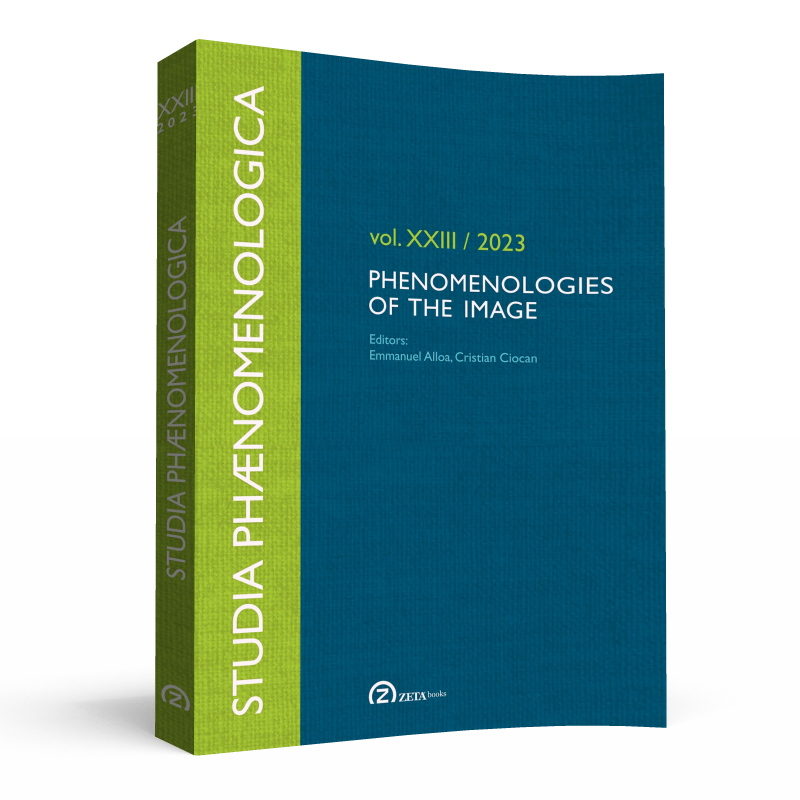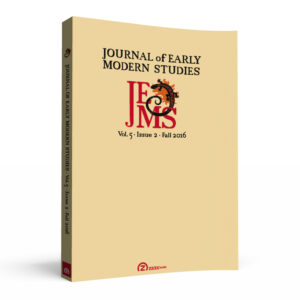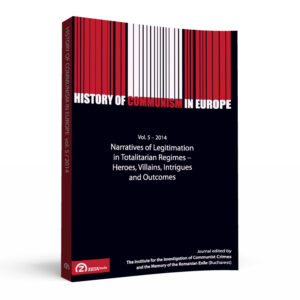Emmanuel Alloa & Cristian Ciocan, Phenomenologies of the Image: Editors’ Introduction [OPEN ACCESS]
Seyran Sam, The Limits of Imagination in Husserl
Abstract: This paper attempts to examine imagination with respect to its two poles and argues that in the phenomenological framework the locus of imagination is one between perception and ideation. Where imagination approaches perception we encounter the terminus a quo of imagination and therefore its lower limit and where it approximates ideation, we encounter its terminus ad quem and therefore its upper limit. In the former case we find the first form of imagination, which is the least articulated sense of imagination: image‑consciousness. In the latter case we find the last form of imagination, which is the most articulated sense of imagination: free phantasy. On the one hand, then, image‑consciousness is delineated from perception, and accordingly it is delineated from something that is determined. On the other hand, free phantasy is delineated from ideation, and as such it is delineated from something that is determining it. Situated between something that is determined and something that is determining it, the different forms of imagination can be said to have acquired different levels of freedom; imagination becomes freer the more it departs from perception and the more it approximates ideation.
Lorenzo Biagini, Figurative Speech as Phenomenological Problem: Reflections on the Role of Linguistic “Images” in Husserl’s Philosophy
Abstract: This article aims to investigate the nature and role of linguistic “images” in Husserl’s philosophy. At first, I will explain the idea of rigorous language emerging in relevant pages of Ideas I as well as the challenges that linguistic “images” pose to it. I will then examine the nature of linguistic “images,” relying on the reflections collected in Husserliana XXIII to show their nature of intuitive‑imaginative syntheses. Finally, I will focus on the role that such “images” play in phenomenologizing. Taking decisive cues from Fink and Adorno, I will show the figurative essence of Husserl’s operative concepts and the productivity of “conceptual constellations” in phenomenology. The main contention of this article is that the rigor of phenomenological language essentially relies on a peculiar imaginative experience.
Irene Breuer, Cassirer und Husserl: Bilder als Exempel und Exemplare – ihre Funktion in Wahrnehmung und Kunst. Ein Beitrag zu einer Hermeneutik des Ausdrucks
Abstract: This article inquires firstly into the descriptive and affective function of images as examples and exemplars in both Cassirer’s and Husserl’s conceptions of perception and aesthetics in order to disclose their respective relationship to reality, that is, mimesis. In view of the correlation between symbolic comportment and symbolic forms at Cassirer, it will secondly show that the ensuing hermeneutical circle can be overcome by taking recourse on Husserl’s genetic analyses on passive sense constitution. It will thus set the basis for a “hermeneutics of expression” that should, thirdly, shed light on the possibility of establishing an aesthetical knowledge. For this purpose, it will disclose an excess of sensuous expression that is determined by a pre‑categorial limit‑concept within the process of sense‑formation. This inquiry shows that, while images as examples are characterized by their ideal arbitrariness, aesthetic images as singular and categorially determined exemplars can be understood as the affective expression of reality.
Witold Płotka, Ingarden and Blaustein on Image Consciousness
Abstract: The article explores two phenomenologies of image consciousness that were formulated by Ingarden and Blaustein, both of whom were students of Husserl. Both philosophers analyze image consciousness in the context of the phenomenon of contemplating a painting. The article is divided into seven sections. Section 1 presents the historical background of Blaustein’s and Ingarden’s explorations. In Section 2, Ingarden’s description of a painting as different from an image is reconstructed. In Section 3, Ingarden’s analysis of Husserl’s image consciousness is discussed. Section 4 concerns Blaustein’s theory of intentionality, which was formulated in a critical elaboration of Husserl’s philosophy. Section 5 discusses the detailed components of Blaustein’s theory of intentionality, i.e., his theory of psychic representations. This theory is then used in Section 6 in an analysis of Blaustein’s reading of § 111 of Husserl’s Ideas I. Section 7 summarizes both theories in order to draw parallels and differences between Ingarden and Blaustein. In this regard, it is argued that both philosophers refer to different theoretical contexts when discussing Husserl’s idea of image consciousness.
César Gómez Algarra, Une pensée sans images ? Phantasie et Bild dans les traités de l’histoire de l’Être
Abstract: In his conference “The Age of the World Picture” (1938), Heidegger displays a strong criticism of the concept of image (Bild). More precisely, the German philosopher rejects any consideration of the image, as he correlates the image with the process of subjective representation (Vorstellung). At first glance, that position does not seem to change in his posthumous works written from 1930 to 1940, where Heidegger develops his Ereignis‑thinking. However, a more thorough study of the writings (from the Beiträge zur Philosophie to Das Ereignis and the Black Notebooks) allows us to reconsider the scope of that common idea. In this paper, I analyze the project of a thinking without images (bildloses Denken) and of imagination (Phantasie) elaborated throughout the private writings. My aim is to re‑examine the extent of Heidegger’s refusal of images, in order to prove that, in the end, his essay of a thinking without images cannot escape their ontological weight.
Shawn Loht, Not All Picturing is Picturing: Heidegger on the Possibility of Authentic Meaning in Images, Film, and Photography
Abstract: This article examines selected texts in which Martin Heidegger thematizes the ontology of images, in order to adduce a view of how he understands their merits and limitations. I am primarily interested in the images seen in art works, especially those in film and photography, given Heidegger’s strong criticism of the latter alongside other 20th‑century communicative media. The goal of the article is not to determine what is Heidegger’s central or overall position regarding images, as it is not clear that he has such a position. Rather, the goal is to analyze how his various statements on images, as well as imagination, fit together. I contrast Heidegger’s critical views in “The Age of the World Picture” with other texts in which he describes images more favorably. I also devote some space to texts in which Heidegger treats imagination and the origin of images more broadly.
Simone Villani, Andrea Altobrando, Realizing the Imaginary: Mental Images and the Instruments of Freedom [OPEN ACCESS]
Abstract: We provide a phenomenological explanation of the particular function mental images play in the realization of enjoyment and their significance for human freedom on the basis of the idea, drawn from Sartre, that images are not things but rather a way consciousness behaves towards objects. The mental image’s matter, which consists of affectivity, knowledge, and kinaesthetic operations, allows imagination to conjure up an unreal item to satiate a desire. However, by foreshadowing enjoyment in the imaginary, the mental image urges consciousness toward a change in the world that would make that enjoyment real. This is accomplished through the development of tools, which rely on the ability to overcome not just a given situation but also courses of goal‑oriented behaviour that have already been prepared by the environment. Through this creation, consciousness exerts its freedom within reality, and marks the world as meaningful.
Huaiyuan Zhang, The Parallax View between Merleau‑Ponty and Lacan: “Never Do You Gaze at Me There Where I See You”
Abstract: Since Narcissus sees himself seeing himself, i.e., comes to self‑consciousness and plunges into self‑destruction under the gaze, thinkers have problematized the Delphic maxim of “knowing thyself ” from a visual perspective. In this trend, psychoanalysis joins the self‑criticism of phenomenology in subverting the “myth” of the self‑reflective consciousness. Whereas Lacan relegates the mirror stage to the Imaginary and interprets the gaze as objet a to account for the split in the subject, Merleau‑Ponty overcomes the narcissistic enclosure of the tacit cogito by appealing to the self ’s abandonment to the gaze of the other in an open‑circuit of the reversible flesh. Through the lens of the topological concept of parallax, this study illuminates the fundamental distinctions between these two perspectives and proposes a promising future of psychoanalytic phenomenology.
Alex Obrigewitsch, The Image of Impossibility Binding Literature and Phenomenology: Blanchot and Levinas
Abstract: Rather than examining the possibilities of the relation between phenomenology and literature as they are conditioned by the imaginary image, this paper takes up the impossibility essential to this relation, bound to the question of its experience, to the experience of literature. The question of what “the experience of literature” is, what it signifies and directs itself towards, is explicated and unravelled in an analysis of the experience of the writer (and, at times, the reader), with the aid of Emmanuel Levinas’ few engagements with art and literature, paired with the thought of Maurice Blanchot on the interruption of writing (in both the subjective and objective genitives). In tracing what passes through consciousness in this experience of literature, marking its impasses and its faltering approaches, the impossibility exposed in the experience of literature shall be shown to be necessary for opening and maintaining the distance binding phenomenology and literature in their separation and their traversal of the image.
Erik Lind, L’équivoque de l’image chez Henri Maldiney
Abstract: Henri Maldiney’s aesthetics can be seen as an attempt to push traditional phenomenological descriptions of the image, such as can be found in the works of Husserl and Sartre, to their theoretical limits. In this paper, I examine how Maldiney’s phenomenological approach to visual works of art leads him to disclose a non‑intentional dimension of the image which is that of “form.” At this level, the image is not primarily a structure or modification of consciousness, but a mode of presence to the world. Next, in turning towards what Maldiney considers to be non‑objective forms of pictorial representation, exemplified by Byzantine mosaics and the works of Paul Cézanne, I show how this presence is articulated rhythmically in a tension which embraces both image and viewer. Finally, I explore the meaning of Maldiney’s claim that the image is not an imitation of reality, but synonymous with reality itself.
Samuel Lelièvre, Une philosophie ricoeurienne de l’image
Abstract: While inheriting from Husserl’s phenomenology, Ricoeur aims at determining a philosophical anthropology. Imagination can then be thought as what makes possible a mediation dealing with the disproportion between sensibility and understanding; it can be seen as one of the guiding threads of Ricoeur’s anthropology before becoming a theme or a field of analysis. But if this philosophy of imagination encompasses the issue of image, to the point of making these two terms mostly interchangeable, it too includes a specific philosophy of image, which must be recovered. In this perspective, one could follow a path going from the most general standpoint (the elaboration of a philosophy of image in the wake of a phenomenology of imagination) to the most particular one (the recognition of the image as a symbol, sign or trace) while determining the role of symbolic mediation related to image.
Stephanie Rumpza, The Icon as Revelation: Phenomenological Reframing a Double Polemic
Abstract: The Orthodox icon is often claimed as unique among images. Yet many proponents of this view, such as Leonid Ouspensky and Pavel Florensky, defend this singularity through a polemic against Western realism using a logic that culminates in a polemic against the world of experience. In this paper, I will use phenomenology to dismantle these two false dualities, against realist images and real experience, by uncovering the deeper concerns that motivate them. First, I draw on Merleau‑Ponty’s phenomenology of painting to collapse the dichotomy of carnal and spiritual images. Then, I use Jean‑Luc Marion’s phenomenality of Revelation to reframe the dichotomy of worldly and spiritual experience. This broadened understanding of experience will serve as a starting point to refine our understanding of what is claimed by the icon, both in its function as an image and in the world it opens for those who approach it on its own terms.
Fabrizia Bandi, Phenomenology of VR Images: Phantasy, Image and Perception [OPEN ACCESS]
Abstract: The purpose of the article is to offer a phenomenological description of VR images and their experience. In the first section, I briefly present the peculiar features of these kinds of images; in the second section, I compare VR images with phantasms, especially in the light of the idea of “presentification” (Vergegenwärtigung), and then I discuss the reality or unreality of VR image‑objects; the third section elaborates an analysis of VR images according to the notions of image object (Bildobjekt), and discusses the issue of “presence” both of the representing image and the user; finally, in the last section, I focus on the correlated experience of the subject, which I describe as a switching between image consciousness and perceptual apprehension.
VARIA
Michel Dalissier, L’imperceptible – Merleau‑Ponty
Abstract: What does the imperceptible mean? Is not such a question unavoidable for Maurice Merleau‑Ponty, who is an illustrious thinker of perception? In this paper, I demonstrate that the French philosopher, in his published texts and unpublished manuscripts, provides an insightful reflection regarding the phenomenon of imperceptibility, which permeates some main domains of his thought. I underscore that his approach is articulated on two intimately related concepts, namely the imperceptible and the imperception. I start by unveiling Merleau‑Ponty’s archetypal refusal of two extreme philosophical positions that conceive of the imperceptible, on the one hand, as a purely factitious or factual entity, and, on the other hand, as a radical and absolute reality. This approach leads me to discuss Merleau‑Ponty’s keynote conception, namely an imperceptibility that appears paradoxically at work for perception. I show that such an interdependence between imperception and perception typically takes for him the form of a specific chiasm, of which I scrutinize several notable expressions. Lastly, I address Merleau‑Ponty’s insightful sketch of an even further sophisticated theory, wherein imperception would be eventually reintegrated within perception itself.
Petr Prášek, A Theological Turn in Phenomenology? Janicaud and Contemporary French Phenomenology
Abstract: While correctly emphasizing that the idea of theological inspiration in phenomenology and vice versa might be very fecund, the current discussion on the theological turn does not always affirm that Janicaud was simply wrong as regards the characterization of new French phenomenology. This is why it is necessary to create a more balanced image of the discussions on the theological turn and contemporary phenomenology. The paper achieves this aim 1) by demonstrating that there was no theological turn in French phenomenology; 2) by analysing the true nature of the turn taking place in phenomenology. It concludes by affirming that contemporary French phenomenology—freed from the label “theological turn”—is a living branch of philosophy capable of contributing to the solution of some of the burning issues of today’s world, such as ecological crisis.
REVIEW ARTICLE
Elizabeth A. Behnke, A Tale of Two Spaces
[Elsa Ballanfat, L’espace vide: Phénoménologie et chorégraphie, Bucharest: Zeta Books, 2021, 459 pp., ISBN 978‑606‑697‑132‑4, € 24.00 (paperback); ISBN: 978‑606‑697‑133‑1, € 15.00 (e‑book); Tao DuFour, Husserl and Spatiality: A Phenomenological Ethnography of Space, Routledge Research in Architecture, London and New York: Routledge, 2022, xvi + 251 pp., ISBN: 978‑081‑536‑155‑8, $136.00 (hardback); ISBN: 978‑103‑210‑309‑9, $52.95 (paperback); ISBN: 978‑135‑111‑614‑5, $42.36 (e‑book)]
BOOK REVIEW
Delia Popa, Andreea Smaranda Aldea, David Carr, Sara Heinämaa (eds.), Phenomenology as Critique. Why Method Matters (Routledge, 2022)
ISSN: 1582-5647 (print)
ISSN: 2069-0061 (online)
Related products
-
Journal of Early Modern Studies, Volume 5, Issue 2 (Fall 2016)
CORNEANU, Sorana; ALEXANDRESCU, Vlad (eds.)
Select optionsThis product has multiple variants. The options may be chosen on the product page€15.00 – €100.00
-
History of Communism in Europe: Vol. 5 / 2014: Narratives of Legitimation in Totalitarian Regimes – Heroes, Villains, Intrigues and Outcomes
BATHORY, Dalia (ed.)
Select optionsThis product has multiple variants. The options may be chosen on the product page€12.00 – €100.00
-
Journal of Early Modern Studies, Volume 6, issue 2 (Fall 2017)
CORNEANU, Sorana (ed.)
Select optionsThis product has multiple variants. The options may be chosen on the product page€15.00 – €100.00
-
Journal of Early Modern Studies, Volume 2, Issue 2 (Fall 2013)
CORNEANU, Sorana (ed.)
Select optionsThis product has multiple variants. The options may be chosen on the product page€15.00 – €100.00

 [
[


